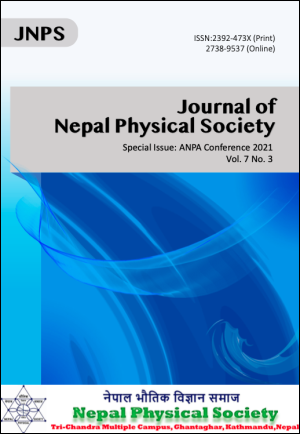Studies of the Properties of Dust Structure Nearby the Supernova Remnants G053.41+00.3, G053.9+00.2 and G053.1+00.3 using Data from IRIS and AKARI
DOI:
https://doi.org/10.3126/jnphyssoc.v7i3.42192Keywords:
Supernova RemnantsAbstract
The search of isolated dust structure is performed around the Supernova Remnants using SkyView Virtual Observatory in IRIS and AKARI survey. An isolated dust structure at Galactic Longitude: 53.54° and Galactic Latitude: +0.04° (RA: 292.56°, DEC: 18.24°) is selected for this work. The intensity of infrared fluxes are extracted from the FITS image using Aladin v2.5 and v11.0 software. The dust color temperature and dust mass are calculated from infrared flux. The distribution of infrared fluxes, dust color temperature and dust mass are studied via color map and Gaussian plot using Python 3.8. The dust color temperature is found larger in IRIS data but the dust mass is found more in AKARI data. We use Gaia EDR3 for the calculation of distance, which is 1667.89 pc. The background sources within the dust structure is studied using SIMBAD database. The color map shows an identical distribution for infrared fluxes in both IRIS and AKARI data; but for dust color temperature and dust mass, the distribution is different. The large fluctuation of temperature indicates that dust structure is beyond the local thermodynamic
equilibrium. The distribution of infrared fluxes and dust color temperature deviates from Gaussian nature, indicating the dust structure is not evolving independently and the background radiation sources such as Supernova Remnants, Pulsars, etc. are playing major roles for the asymmetrical distribution. A study of inclination angle suggests the dust structure is non-uniform and irregular in its internal morphology. A good correlation between infrared fluxes is observed in both IRIS and AKARI data. Also, an inverse relation between dust color temperature and spectral index is observed for both data. It can be concluded that the high radiation sources within and outside the dust structure are playing a major role in the asymmetrical distribution of infrared flux and dust color temperature.
Downloads
Downloads
Published
How to Cite
Issue
Section
License
All right reserved. No part of this Journal may be reproduced in any form or by any electronic or mechanical means, including information storage and retrieval system, without permission in writing from the publisher, except by a reviewer who may quote brief passage in a review. The views and interpretation in this journal are those of author(s) and they are not attributable to the NPS.




